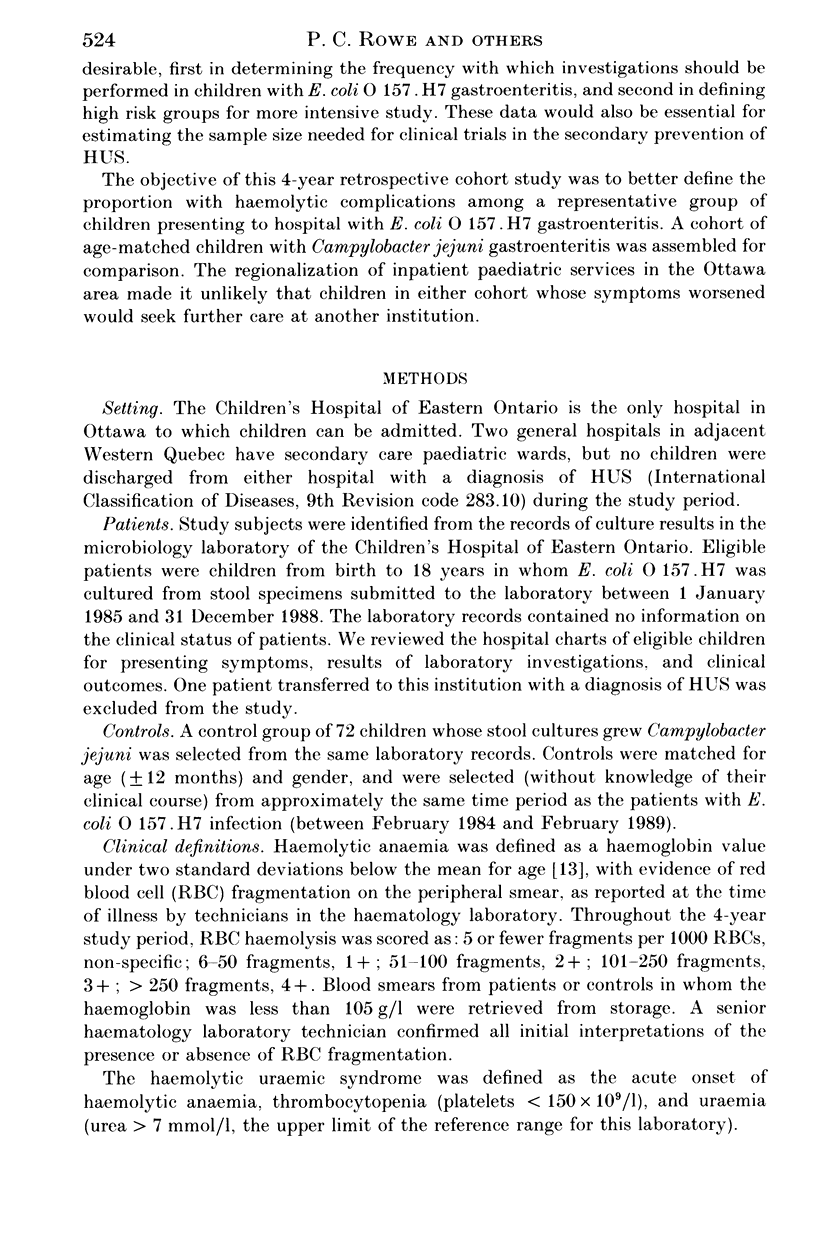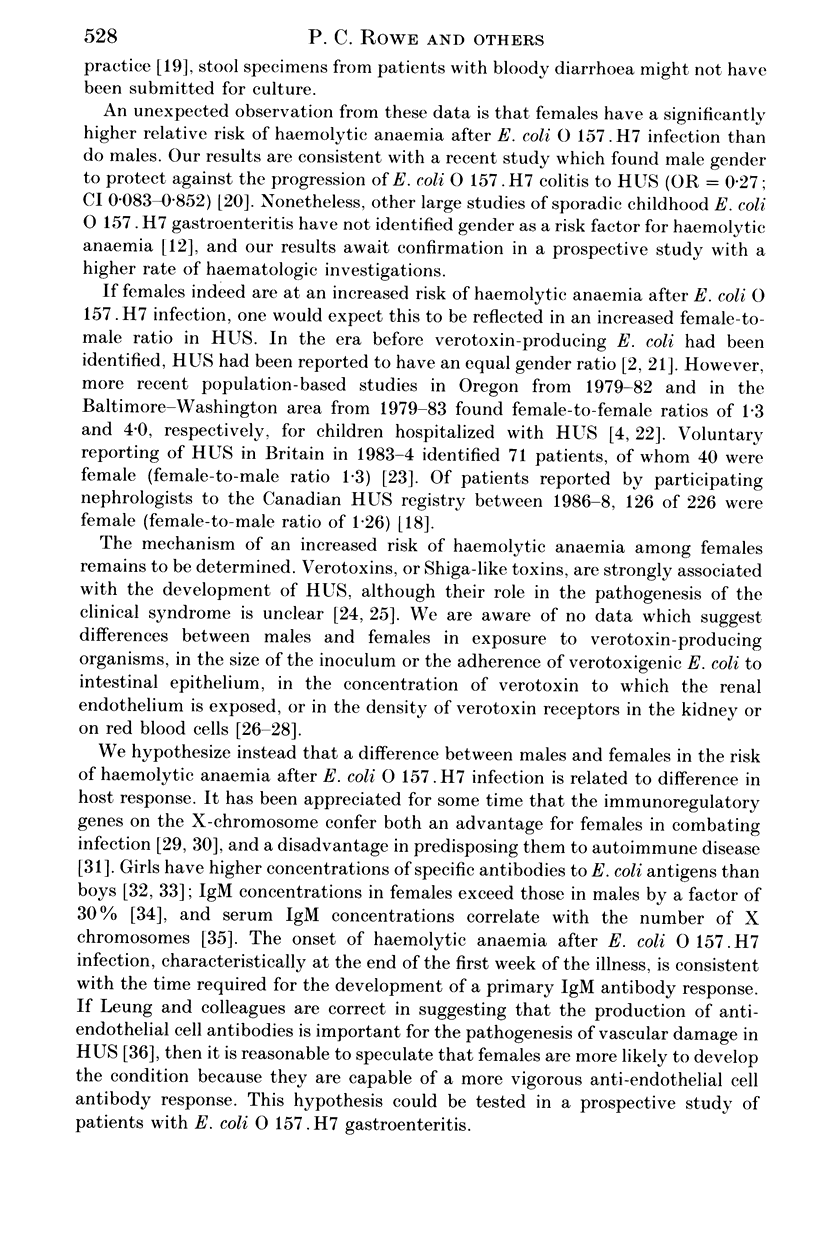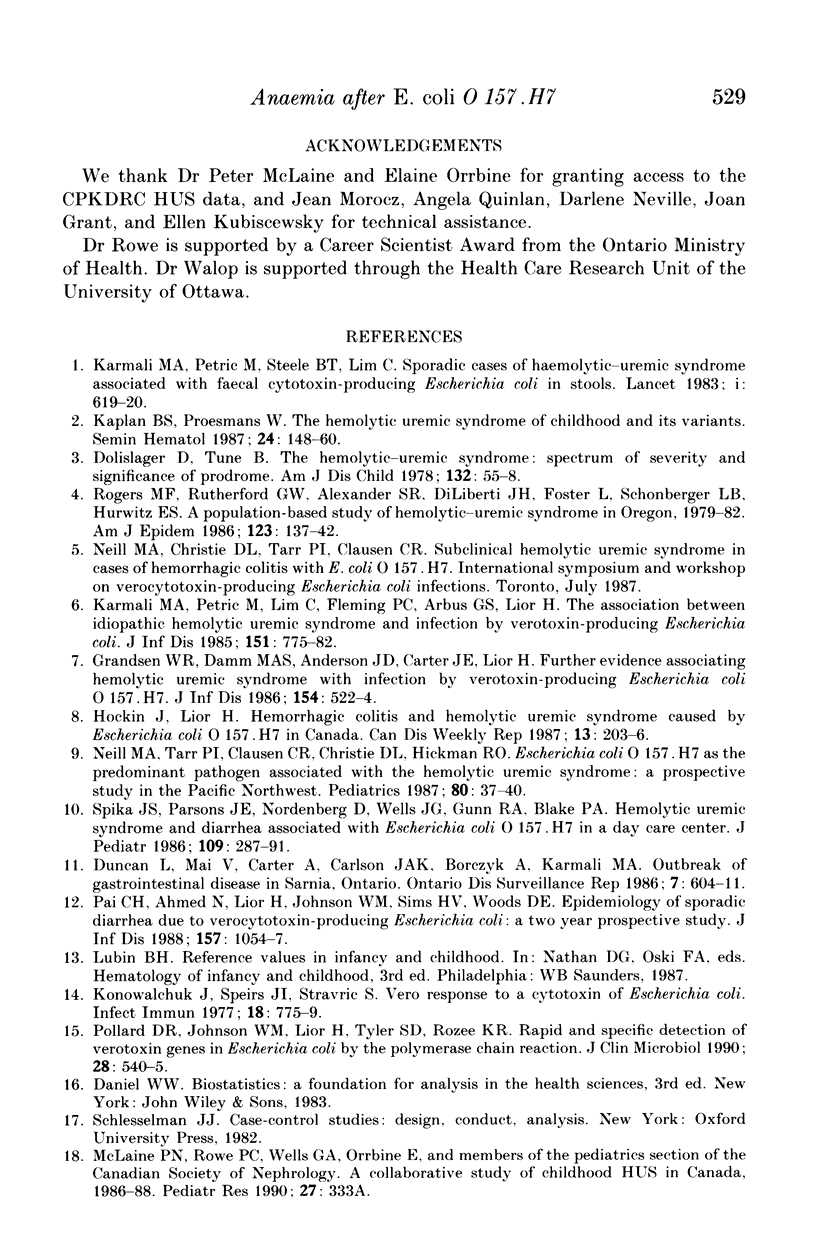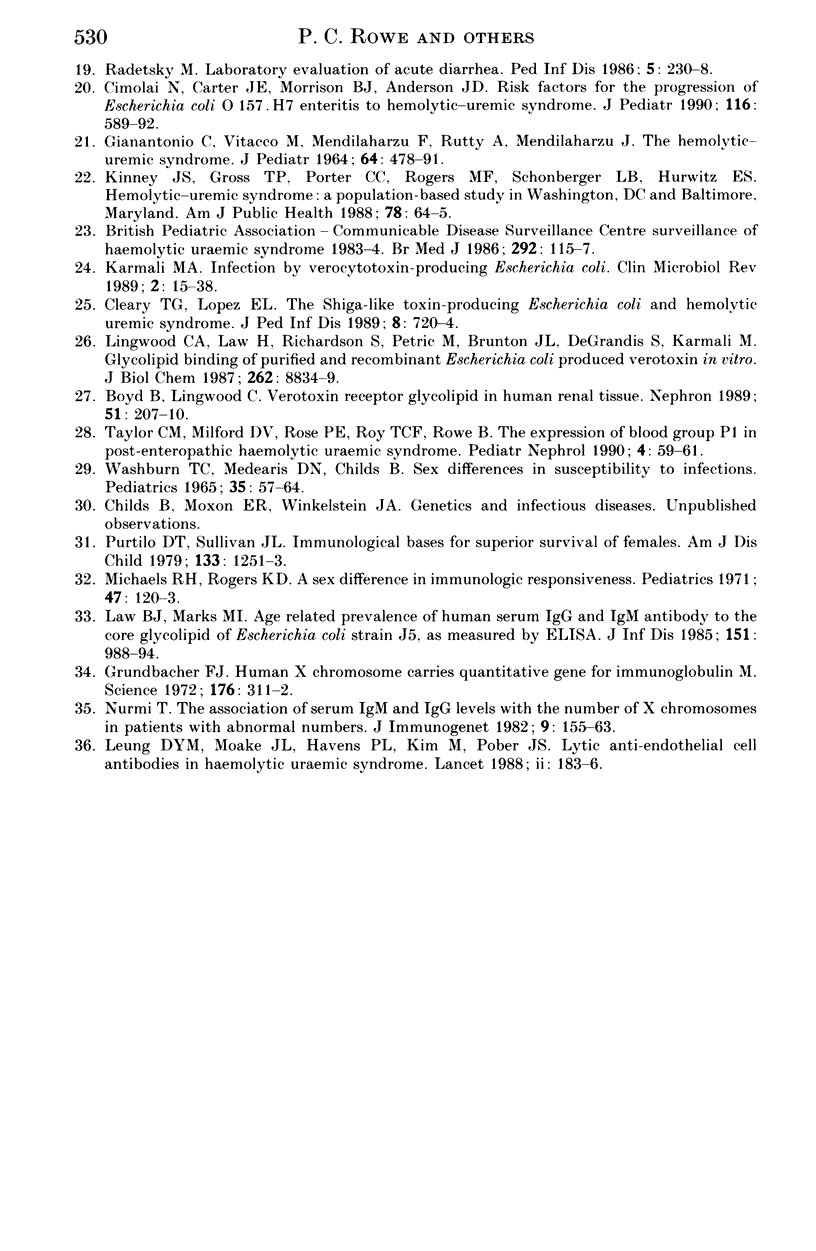Abstract
We conducted a 4-year retrospective cohort study to better define the risk of haemolytic anaemia and haemolytic uraemic syndrome (HUS) in children following sporadic gastrointestinal infection with the O 157.H7 serotype of Escherichia coli. Of the 72 children infected with this organism, 9 (12.5%) developed haemolytic anaemia, 6 of whom had HUS. No child in a cohort of 72 age-matched controls with Campylobacter jejuni gastroenteritis developed haemolytic anaemia (P = 0.003). Females had a significantly greater risk of developing haemolytic anaemia after E. coli O 157. H7 infection than did males (8/29 females v. 1/43 males; P = 0.003). In a logistic regression model, female gender emerged as the only statistically significant risk factor for haemolytic anaemia (odds ratio 3.85; 95% confidence interval 1.24-12). These results are consistent with recent reports of a moderate increase in the risk of HUS for females.
Full text
PDF







Selected References
These references are in PubMed. This may not be the complete list of references from this article.
- Boyd B., Lingwood C. Verotoxin receptor glycolipid in human renal tissue. Nephron. 1989;51(2):207–210. doi: 10.1159/000185286. [DOI] [PubMed] [Google Scholar]
- Cimolai N., Carter J. E., Morrison B. J., Anderson J. D. Risk factors for the progression of Escherichia coli O157:H7 enteritis to hemolytic-uremic syndrome. J Pediatr. 1990 Apr;116(4):589–592. doi: 10.1016/s0022-3476(05)81609-9. [DOI] [PubMed] [Google Scholar]
- Cleary T. G., Lopez E. L. The shiga-like toxin-producing Escherichia coli and hemolytic uremic syndrome. Pediatr Infect Dis J. 1989 Oct;8(10):720–724. doi: 10.1097/00006454-198910000-00012. [DOI] [PubMed] [Google Scholar]
- Dolislager D., Tune B. The hemolytic-uremic syndrome: spectrum of severity and significance of prodrome. Am J Dis Child. 1978 Jan;132(1):55–58. doi: 10.1001/archpedi.1978.02120260057014. [DOI] [PubMed] [Google Scholar]
- GIANANTONIO C., VITACCO M., MENDILAHARZU F., RUTTY A., MENDILAHARZU J. THE HEMOLYTIC-UREMIC SYNDROME. J Pediatr. 1964 Apr;64:478–491. doi: 10.1016/s0022-3476(64)80337-1. [DOI] [PubMed] [Google Scholar]
- Gransden W. R., Damm M. A., Anderson J. D., Carter J. E., Lior H. Further evidence associating hemolytic uremic syndrome with infection by Verotoxin-producing Escherichia coli O157:H7. J Infect Dis. 1986 Sep;154(3):522–524. doi: 10.1093/infdis/154.3.522. [DOI] [PubMed] [Google Scholar]
- Grundbacher F. J. Human X chromosome carries quantitative genes for immunoglobulin M. Science. 1972 Apr 21;176(4032):311–312. doi: 10.1126/science.176.4032.311. [DOI] [PubMed] [Google Scholar]
- Kaplan B. S., Proesmans W. The hemolytic uremic syndrome of childhood and its variants. Semin Hematol. 1987 Jul;24(3):148–160. [PubMed] [Google Scholar]
- Karmali M. A. Infection by verocytotoxin-producing Escherichia coli. Clin Microbiol Rev. 1989 Jan;2(1):15–38. doi: 10.1128/cmr.2.1.15. [DOI] [PMC free article] [PubMed] [Google Scholar]
- Karmali M. A., Petric M., Lim C., Fleming P. C., Arbus G. S., Lior H. The association between idiopathic hemolytic uremic syndrome and infection by verotoxin-producing Escherichia coli. J Infect Dis. 1985 May;151(5):775–782. doi: 10.1093/infdis/151.5.775. [DOI] [PubMed] [Google Scholar]
- Karmali M. A., Steele B. T., Petric M., Lim C. Sporadic cases of haemolytic-uraemic syndrome associated with faecal cytotoxin and cytotoxin-producing Escherichia coli in stools. Lancet. 1983 Mar 19;1(8325):619–620. doi: 10.1016/s0140-6736(83)91795-6. [DOI] [PubMed] [Google Scholar]
- Kinney J. S., Gross T. P., Porter C. C., Rogers M. F., Schonberger L. B., Hurwitz E. S. Hemolytic-uremic syndrome: a population-based study in Washington, DC and Baltimore, Maryland. Am J Public Health. 1988 Jan;78(1):64–65. doi: 10.2105/ajph.78.1.64. [DOI] [PMC free article] [PubMed] [Google Scholar]
- Konowalchuk J., Speirs J. I., Stavric S. Vero response to a cytotoxin of Escherichia coli. Infect Immun. 1977 Dec;18(3):775–779. doi: 10.1128/iai.18.3.775-779.1977. [DOI] [PMC free article] [PubMed] [Google Scholar]
- Law B. J., Marks M. I. Age-related prevalence of human serum IgG and IgM antibody to the core glycolipid of Escherichia coli strain J5, as measured by ELISA. J Infect Dis. 1985 Jun;151(6):988–994. doi: 10.1093/infdis/151.6.988. [DOI] [PubMed] [Google Scholar]
- Leung D. Y., Moake J. L., Havens P. L., Kim M., Pober J. S. Lytic anti-endothelial cell antibodies in haemolytic-uraemic syndrome. Lancet. 1988 Jul 23;2(8604):183–186. doi: 10.1016/s0140-6736(88)92287-8. [DOI] [PubMed] [Google Scholar]
- Lingwood C. A., Law H., Richardson S., Petric M., Brunton J. L., De Grandis S., Karmali M. Glycolipid binding of purified and recombinant Escherichia coli produced verotoxin in vitro. J Biol Chem. 1987 Jun 25;262(18):8834–8839. [PubMed] [Google Scholar]
- Michaels R. M., Rogers K. D. A sex difference in immunologic responsiveness. Pediatrics. 1971 Jan;47(1):120–123. [PubMed] [Google Scholar]
- Neill M. A., Tarr P. I., Clausen C. R., Christie D. L., Hickman R. O. Escherichia coli O157:H7 as the predominant pathogen associated with the hemolytic uremic syndrome: a prospective study in the Pacific Northwest. Pediatrics. 1987 Jul;80(1):37–40. [PubMed] [Google Scholar]
- Nurmi T. The association of serum IgM and IgG levels with the number of X chromosomes in patients with abnormal number of X chromosomes. J Immunogenet. 1982 Jun;9(3):155–163. doi: 10.1111/j.1744-313x.1982.tb00786.x. [DOI] [PubMed] [Google Scholar]
- Pai C. H., Ahmed N., Lior H., Johnson W. M., Sims H. V., Woods D. E. Epidemiology of sporadic diarrhea due to verocytotoxin-producing Escherichia coli: a two-year prospective study. J Infect Dis. 1988 May;157(5):1054–1057. doi: 10.1093/infdis/157.5.1054. [DOI] [PubMed] [Google Scholar]
- Pollard D. R., Johnson W. M., Lior H., Tyler S. D., Rozee K. R. Rapid and specific detection of verotoxin genes in Escherichia coli by the polymerase chain reaction. J Clin Microbiol. 1990 Mar;28(3):540–545. doi: 10.1128/jcm.28.3.540-545.1990. [DOI] [PMC free article] [PubMed] [Google Scholar]
- Purtilo D. T., Sullivan J. L. Immunological bases for superior survival of females. Am J Dis Child. 1979 Dec;133(12):1251–1253. doi: 10.1001/archpedi.1979.02130120043008. [DOI] [PubMed] [Google Scholar]
- Radetsky M. Laboratory evaluation of acute diarrhea. Pediatr Infect Dis. 1986 Mar-Apr;5(2):230–238. doi: 10.1097/00006454-198603000-00015. [DOI] [PubMed] [Google Scholar]
- Spika J. S., Parsons J. E., Nordenberg D., Wells J. G., Gunn R. A., Blake P. A. Hemolytic uremic syndrome and diarrhea associated with Escherichia coli O157:H7 in a day care center. J Pediatr. 1986 Aug;109(2):287–291. doi: 10.1016/s0022-3476(86)80386-9. [DOI] [PubMed] [Google Scholar]
- Taylor C. M., Milford D. V., Rose P. E., Roy T. C., Rowe B. The expression of blood group P1 in post-enteropathic haemolytic uraemic syndrome. Pediatr Nephrol. 1990 Jan;4(1):59–61. doi: 10.1007/BF00858441. [DOI] [PubMed] [Google Scholar]
- WASHBURN T. C., MEDEARIS D. N., Jr, CHILDS B. SEX DIFFERENCES IN SUSCEPTIBILITY TO INFECTIONS. Pediatrics. 1965 Jan;35:57–64. [PubMed] [Google Scholar]


